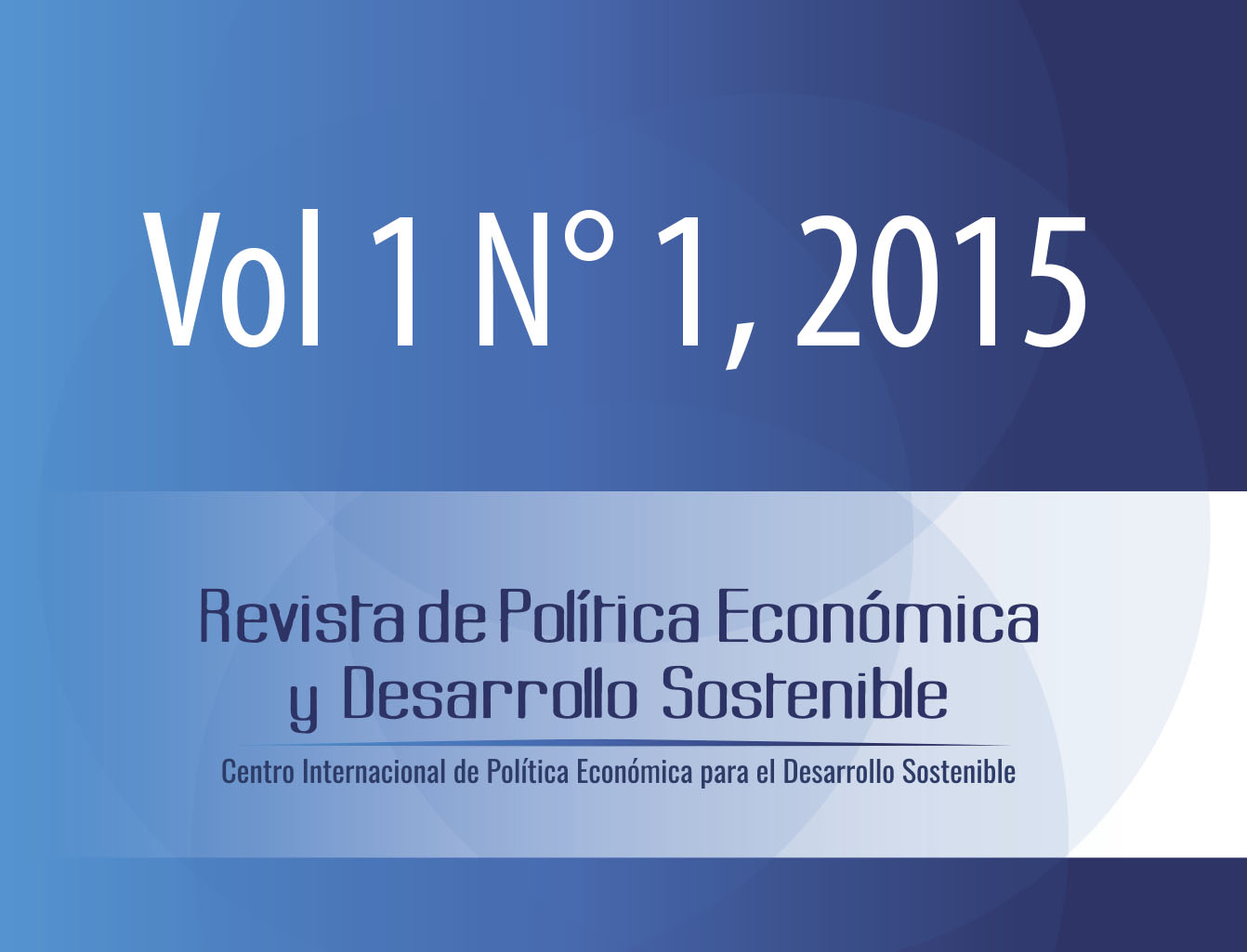Impacto de la diversidad y la participación de los trabajadores sobre la innovación de las empresas: Un modelo de regresión en dos etapas para el sector servicios
DOI:
https://doi.org/10.15359/peds.1-1.2Keywords:
diversity by sex, spaces for participation in firms, innovation on servicesAbstract
Traditionally, innovation processes have been associated to investments in research and development (R&D) or in staff training. This has led innovation studies to focus on technological advance issues leaving aside, sometimes, incremental processes of change and improvement that will eventually become substantial changes in firms. In this work, we attempt to determine the impact of other factors such as workforce diversity and participation on enterprise innovation. The diversity factor relates to organizational composition aspects by workforce’s sex and education level; the participation factor deals with spaces for discussion of ideas, origin of participation initiatives in processes of change, and involvement in the different phases of the innovation processes. A two-step Heckman regression model is used to determine the implications of the aforementioned variables on innovation of enterprises in the service sector. The first section of the paper conceptualizes innovation; the second section focuses on explaining the theoretical associations of selected variables on innovation together with descriptive statistics, which evidences the behavior of variables. A third section is devoted to the model’s specification, and the fourth section shows the main results and, finally, a series of policy implications arising from the results of the model.
References
Referencias
Andries, P., Czarnitzki, D. (2014). Small firm innovation performance and employee involment. New York: Springer Science Business Media (43) 21-38.
Arocena, R. y Sutz, J. (2002). Sistemas de Innovación y Países en Desarrollo. Universidad de la República de Uruguay. SUDESCA.
Bantel, K., & Jackson, S. (1989). Top management and innovation in banking: does the composition of the top team make a difference? Strategic Management Journal, 10, 107-124.
Barney, J. B., & Wright, P. M. (1998). On becoming a strategic partner: The role of human resources in gaining competi- tive advantage. Human Resource Management, 37, 31–46.
Cohen, W.M., Levinthal, D.A. (1990). Absorptive capacity: a new perspective of learning and innovation. Administrative Quaterly 35 (1). 128-152.
Corrales, R. (2013). Creación de Capacidades y Competencias para la Innovación del Sector Turístico Costarricense y sus Implicaciones sobre el Desarrollo Local. Tesis de Posgrado, Universidad Nacional de Costa Rica.
Corrales, R. (2014). Propuestas de Política Pública para Procesos de Innovación Inclusiva en el Sector Turístico Costarricense. En Análisis Público (3), Universidad Valparaíso, Chile.
Dijk, M.P., & Sandee, H. (2002). Innovation and small enterprises development in developing countries. En Dijk M.P., Sandee, H. Eds. Innovation and small enterprises in the third world. Chapter 1. Ed. Edward Elgar. UK.
Dosi, G. (1988). Sources, procedures, and microeconomic effects of innovation. Journal of Economic Literature 26 (3). 1120-1171.
Drazin, R., & Rao, H. (2002). Harnessing managerial knowledge to implement product-line extensions: How do mutual fund families allocate portfolio managers to old and new funds? Academy of Management Journal, 45, 609–619.
Edquist, C. (Ed.) (1997). Systems of Innovations: Technologies, Institutions and Organizations. Wiltshire, UK: John de la Mothe Series Editor.
Edquist, C., Hommen, L., & McKelvey, M. (2001). Innovation and Employment: Process versus Producto Innovation. Massachusetts: Edward Elgar Publishing Limited.
Freeman. C. (1987). Technology Policy and Economic Performance: Lessons from Japan. London: Pinter, Publisher.
Freeman, D.A. (2006). On The So-Called: “Huber Sandwich Estimator“ and “Robust Standar Error”. En The American Statician 60 (4), 299-302.
Garcia-Vega, M. (2006). Does techonological diversification promote innovation? An empirical analysis for european firms. Research Policy 35, 230-246.
Gonzáles, C. (2010). Sesgo de Selección Muestral con STATA. Colombia: Universidad ICESI, Departamento de Economía.
Grant, R. M. (1997). The knowledge-based view of the firm: Implications for management practice. Long Range Planning, 30(3), 450–454.
Gujarati, D. (2010). Econometría. (3er Ed.) México: McGraw Hill.
Heckman, J. J. (1979). Sample selection bias as a specification error. En Econometrica, 47(1), 153–161.
Henderson, R. M., & Clark, K. B. (1990). Architectural innovation: The reconfiguration of existing product technologies and the failure of established firms. Administrative Science Quarterly, 35, 9–30.
Hitt, M. A., Bierman, L., Shimizu, K., & Kochhar, R. (2001). Direct and moderating effects of human capital on strategy and performance in professional service firms: A resource- based perspective. Academy of Management Journal, 44(1),13–28.
Knudsen, H. (1995). Employee Participation in Europe. London: SAGE Publications.
Kogut, B., & Zander, U. (1992). Knowledge of the firm, combinative capabilities, and the replication of technology. Organization Science, 3, 383–397.
Lam, A. (2002). Alternative Societal Models of Learning and Innovation in the Knowledge Economy. Denmark: DRUID, Working Paper.
Lam, A. (2010). Innovative Organizations: Structure, Learning and Adaptation. En: Innovation Perspectives for the 21st Century. Madrid: BBVA, Spain,163-175.
Lazear, E. (1999). Globalizations and the market for team-mates. Economic Journal 109, 15–40.
Lundvall, B.-Å. (Ed.) (1992). National Systems of Innovation: Towards a Theory of Innovation and Interactive Learning. London: Pinter Publishers.
Lundvall, B.-Å. (Ed.) (2002). Growth Innotavion and Social Cohesion: The Danish Model. Elgar Publisher.
Lundvall, B.-Å., Johnson, B., Andersen, E.S., & Daum, B. (2001). National System of Production, Innovation and Competence Building. Denmark: Department of Business Studies, Aalborg University.
Nelson, R. (1993). National Innovation Systems: A Comparative Analysis. Illinois: Columbia University.
Nonaka, I. (1991). A dynamic theory of knowledge creation. En Organization Science (5) 14-37.
Nonaka, I., & Takeuchi, H. (1995). The knowledge-creating company. New York: Oxford University Press.
Orozco, J. (2002). Innovation and performance improvements in the Co-operative sector: Costa Rica. Tesis de grado para optar por título de Ph.D. Aalborg, University, Denmark.
Østergaard, C.R., Timmermans, B., & Kristinsson, K. (2011). Does a different view create something new? The effect of employee diversity on innovation. Research Policy 40, 500-509.
Parrotta, P., Pozzoli, D., & Pytlikova, M. (2014). The nexus between labor diversity and firm’s innovation. J Popul Econ 27, 303-364.
Quintana-Garca, C. y Benavides-Velasco, C.A. (2008). Innovative competence, exploration and exploitation: the influence of technological diversification. Research Policy 37, 492-507.
Ruef, M., Aldrich, H., & Carter, N. (2003). The estructure of founding teams: Homophily strong ties and isolation among U.S. entrepreneurs. American Sociological Review 68 (2), 195-222.
Ruiz, K. (2007). Costa Rica as a Learning Economy: An Exploratory Study of Competence-Building and the Significance of Labour Relations and Labour Market Institutions. PhD. Thesis. Aalborg University, Denmark.
Schumpeter, J.A. (1934). The Theory of Economic Development: An Inquiry into Profits, Capital, Credit, Interest, and Business Cycle. Cambridge, MA: Harvard University Press.
van der Vegt, G., & Janssen, O. (2003). Joint impact of interdependence and group diversity on innovation. Journal of Management 29 (5), 729-751.
Wenger, E. (2000). Communities of practise and social learning systems. Organization 7 (2), 225–246.
Wiig, K. M. (1997). Integrating intellectual capital and knowl- edge management. Long Range Planning, 30, 399–405.
Woodman, R., Sawyer, J., & Griffin, R. (1993). Toward a theory of organizational creativity. The Academy of Management Review 18 (2), 293–321.
Wooldridge, J. (2006). Introducción a la Econometría: Un enfoque moderno. México: Ed. Thompson Learning.
Zúñiga Vargas, F. (2004). Why Labour Competence? Key Elements to be considered. Montevideo: ILO/CINTEFOR.







